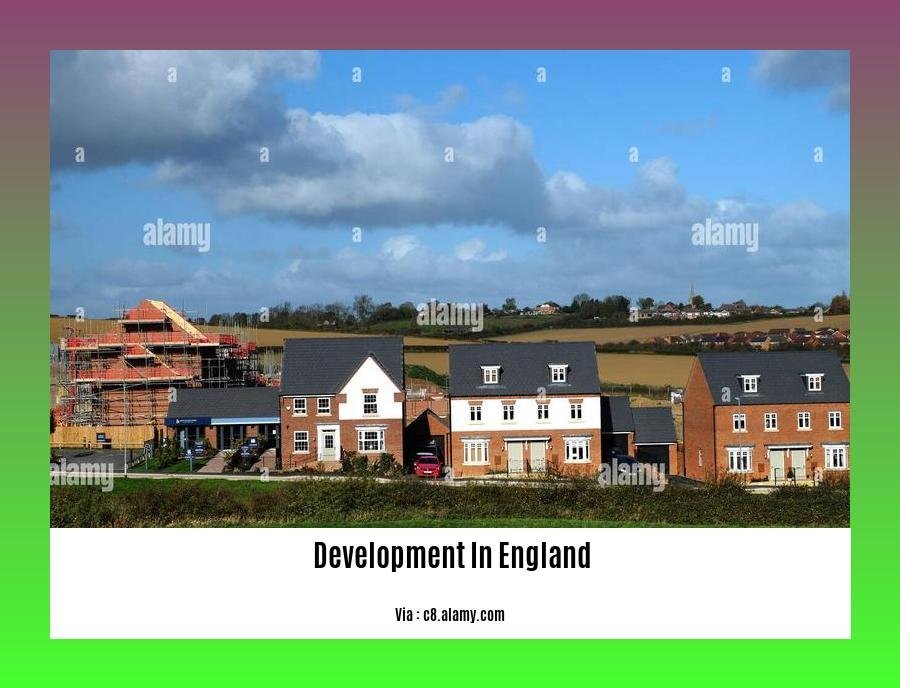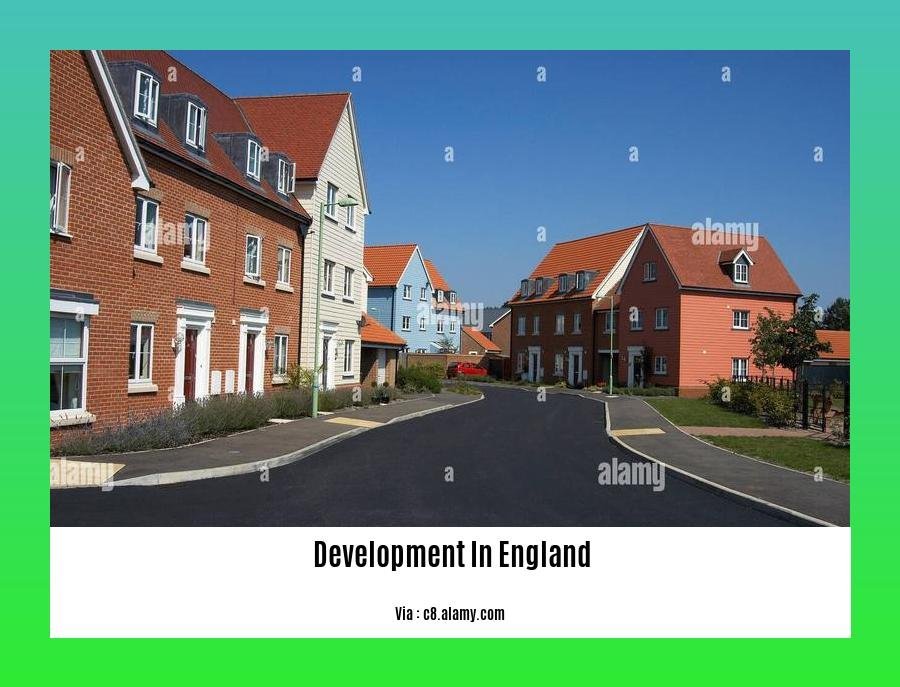Welcome to “The Evolving Tapestry of Urban Development in England,” where we delve into the intricate web of architectural innovation and infrastructure advancements shaping England’s urban landscape. From historic cityscapes to modern metropolises, we’ll explore the driving forces behind urban development in the region. Join us as we unravel the challenges and opportunities that lie ahead for this ever-evolving tapestry.
Key Takeaways:
- UK government invests £900 million in urban regeneration.
- 20 towns and city centers in England will be transformed.
- Regeneration aims to boost economic growth, improve infrastructure, and enhance community well-being.
** development in England: A Resurgence of Urban Landscapes**

England’s urban landscape is undergoing a transformative journey, shaped by a surge in ** development in England**. Fueled by significant investments, this regeneration endeavors to revitalize towns and cities, fostering economic prosperity, infrastructural enhancements, and a thriving sense of community.
Unveiling the Power of Partnership
The government’s commitment to ** development in England** is evident in its £900 million investment, set to transform 20 urban centers across the nation. This strategic initiative harnesses collaboration between local authorities and private developers, creating a shared vision for sustainable and inclusive urban environments.
Redefining Urban Vibrancy
The ** development in England** initiative focuses on enhancing urban vibrancy through strategic interventions:
- Economic Empowerment: Fostering job creation, attracting businesses, and nurturing local industries to stimulate economic growth.
- Infrastructure Overhaul: Upgrading transportation networks, improving energy efficiency, and enhancing digital connectivity to facilitate seamless movement and communication.
- Community Enrichment: Creating accessible green spaces, promoting arts and culture, and investing in social services to foster a sense of belonging and well-being.
Embracing Innovation and Sustainability
** development in England** embraces innovative approaches to sustainability. Green building practices, renewable energy integration, and sustainable transportation options prioritize environmental stewardship while ensuring long-term resilience.
Measuring Success: Metrics of Progress
The effectiveness of ** development in England** will be gauged through tangible metrics, including:
| Indicator | Measure |
—|—|
| Economic Growth | Increased employment, business investment, and GDP |
| Infrastructure Improvements | Enhanced public transportation, energy efficiency, and digital connectivity |
| Community Well-being | Improved health outcomes, reduced crime, and increased social cohesion |
Shaping the Future of England’s Cities
The ** development in England** initiative represents a pivotal moment in shaping the future of the nation’s urban landscape. By prioritizing collaboration, innovation, and sustainability, England is poised to create thriving and resilient cities that empower communities and drive economic prosperity for generations to come.
To better understand the evolution of badminton, delve into the history of badminton, tracing its roots to ancient games and culminating in the formation of the Badminton World Federation.
Environmental sustainability and the challenges of urbanization

In the tapestry of urban development, the pursuit of progress and prosperity often intertwines with the imperative of environmental sustainability. As England’s cities and towns continue to expand and evolve, they face a unique set of challenges in balancing economic growth with the preservation of their natural resources.
Unveiling the impacts of urbanization
Urbanization inevitably exerts a significant impact on the environment. With its dense populations and sprawling infrastructure, cities become hubs of energy consumption, waste generation, and greenhouse gas emissions. Air and water pollution levels rise, compromising the health and well-being of urban dwellers. The loss of green spaces and the fragmentation of habitats pose risks to biodiversity.
Seeking sustainable solutions
Despite these challenges, urbanization also presents opportunities for sustainable practices. Cities offer the potential for efficient waste management, recycling, and energy conservation. The concentration of people and resources can facilitate the implementation of green building technologies, renewable energy sources, and sustainable transportation systems.
England’s urban landscape
In England, the interplay between urbanization and environmental sustainability is particularly evident. The country’s cities, from the bustling metropolis of London to the historic towns of York and Bath, are grappling with the challenges of growth while striving to maintain their environmental integrity.
As England’s urban population continues to grow, both in city centers and suburbs, the demand for housing, infrastructure, and services intensifies. This expansion exerts pressure on green spaces, increases traffic congestion, and amplifies the need for sustainable solutions.
Key Takeaways:
- Urbanization presents both opportunities and challenges for environmental sustainability.
- The impacts of urbanization include increased greenhouse gas emissions, air and water pollution, and reduced biodiversity.
- Urban areas offer potential for sustainable waste management, energy conservation, and green infrastructure.
- England’s urban landscape is facing growth and environmental challenges.
- Striking a balance between urbanization and sustainability is crucial for the future of England’s cities.
Sources:
- Urbanization and Environmental Sustainability: A Review
- The State of the Environment: The Urban Environment
The Future of Urban Development in England
Green Infrastructure
As England continues to urbanize, green infrastructure becomes increasingly vital. Integrating parks, green roofs, and other natural elements into urban planning helps mitigate pollution, reduce heat island effects, and enhance biodiversity.
Compact and Transit-Oriented Development
Compact development promotes dense, mixed-use neighborhoods that reduce urban sprawl and encourage walkability. Transit-oriented development, by building near public transport hubs, reduces congestion and emissions.
Smart Growth and Urban Regeneration
Smart growth manages urban expansion to minimize environmental impact while promoting economic development. Urban regeneration revitalizes declining areas by improving housing, infrastructure, and access to amenities.
Key Takeaways:
- Green infrastructure enhances sustainability and resilience.
- Compact and transit-oriented development reduces sprawl and emissions.
- Smart growth balances environmental and economic goals.
- Urban regeneration revitalizes struggling communities.
Citation:
– The Future of Urban Development
– Sustainable Urban Development Indicators in Great Britain
Case studies of successful urban development projects
Urban development projects can revitalize communities, boost economies, and improve the quality of life for residents. But what makes a successful urban development project?
Key factors to consider:
- Vision: A clear vision for the project is essential.
- Leadership: Strong leadership is needed to guide the project through the planning, implementation, and evaluation phases.
- Stakeholder engagement: Involving stakeholders in the planning process is essential to ensure that the project meets the needs of the community.
- Financial resources: Funding is needed to cover project costs.
- Implementation: Projects must be implemented effectively and efficiently.
- Evaluation: It is important to evaluate projects to measure their success and identify areas for improvement.
Examples of successful urban development projects
- London’s King’s Cross: This former industrial area has been transformed into a vibrant mixed-use neighborhood with new homes, offices, retail space, and public amenities.
- Bristol’s Harbourside: This former dock area has been redeveloped into a thriving cultural and commercial hub with museums, theaters, shops, and restaurants.
Case studies of these projects can provide valuable insights into the factors that contribute to successful urban development.
Key Takeaways:
- Successful urban development projects require a clear vision, strong leadership, stakeholder engagement, financial resources, effective implementation, and evaluation.
- London’s King’s Cross and Bristol’s Harbourside are examples of successful urban development projects.
- Case studies of these projects can provide valuable insights into the factors that contribute to successful urban development.
Relevant URL Sources:
- ULI Case Studies – King’s Cross
- A Case Study of Urban Regeneration in Bristol












